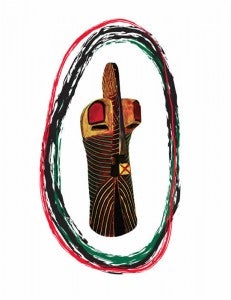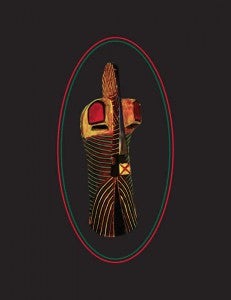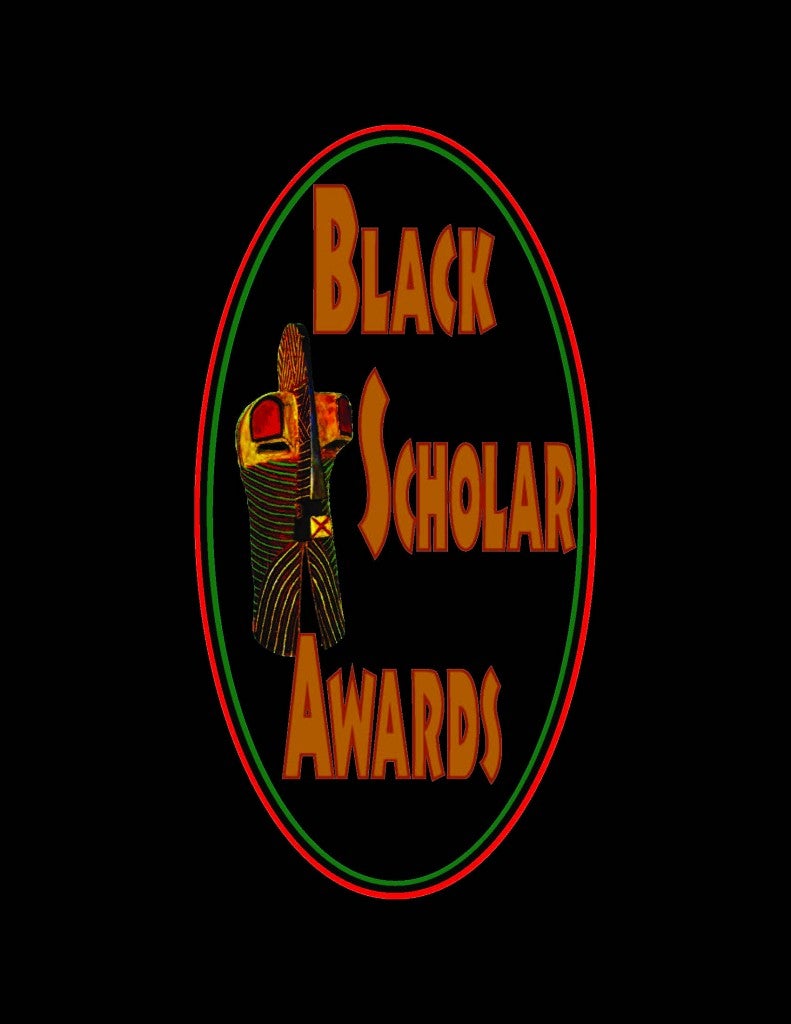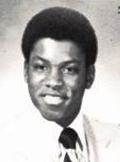Origins of the Black Scholar Awards Logo Mask
The Black Scholar Awards Logo was designed by Jason E. Smith, 2010 David Edmonds Award recipient. Using his knowledge of graphic design, Smith adapted a traditional Songye mask with vibrant colors to highlight an original African work. A detailed description of the mask’s origins is provided below.
______________________________________________________________________________
SONGYE (BASONGE, BASONGYE, BASSONGO, BAYEMBE, SONGE, SONGHAY, WASONGA)
Democratic Republic of the Congo
During the 16th century, the Songye migrated from the Shaba area, which is now the southern part of the Democratic Republic of the Congo. Their history is closely linked to the Luba’s, to whom the Songye are related through common ancestors. Having waged war against one another for a long time, the Songye and Luba later formed an alliance to fight the Arabs. They settled on the left bank of the Lualaba River, on a savanna and forest-covered plateau. Divided into many subgroups, the 150,000 Songye people are governed by a central chief assisted by innumerable secret societies.
The Songye traditionally relied mostly on farming and hunting for subsistence. Because the rivers were associated with the spirits of deceased chiefs who were often buried in them, fishing was not practiced except in times of great need. The artistic wares of the Songye, including pottery made by women and weaving and metalworking done by men, were traded extensively with their neighbors.
The Songye created a sculptural style of intense dynamism and vitality. The works of Songye craftsmen are often used within the secret societies during various ceremonies. They produced a large number of figures belonging to the fetishist, who manipulates them during the rituals of the full moon. Songye fetish figures vary in size from 4″ to 60″.
 They are usually male and stand on a circular base. Strips of metal, nails or other paraphernalia are sometimes applied over the face, which counteract evil spirits and aggressors and channel lightings against them. The top of the head and the abdomen are usually hollowed to allow insertion of fetish material, called boanga. These figures adopt a hieratic posture, the hands placed on a pointed abdomen; on top of the head they have a horn or feathers reinforcing a disquieting appearance. The fetishist would make the boanga with magic ingredients, which he crumbled and mixed, thus obtaining a paste that was kept in an antelope horn hung from the roof of the house. The magic ingredients consist of a wide variety of animal, vegetal, mineral and human substances that activate and bring into play benevolent ancestral spirits. The face is often covered with nails, a reminder of smallpox. The style of Songye fetishes, carved from wood or horn and decorated with shells, is not as realistic as the classic Luba style, and their integration of non-naturalistic, more geometric forms is impressive. The figures are used to ensure their success, fertility, and wealth and to protect people against hostile forces as lightning, as well as against diseases such as smallpox, very common in that region. While smaller figures of this type were kept and consulted by individuals, larger ones were responsible for ensuring the welfare of an entire community.
They are usually male and stand on a circular base. Strips of metal, nails or other paraphernalia are sometimes applied over the face, which counteract evil spirits and aggressors and channel lightings against them. The top of the head and the abdomen are usually hollowed to allow insertion of fetish material, called boanga. These figures adopt a hieratic posture, the hands placed on a pointed abdomen; on top of the head they have a horn or feathers reinforcing a disquieting appearance. The fetishist would make the boanga with magic ingredients, which he crumbled and mixed, thus obtaining a paste that was kept in an antelope horn hung from the roof of the house. The magic ingredients consist of a wide variety of animal, vegetal, mineral and human substances that activate and bring into play benevolent ancestral spirits. The face is often covered with nails, a reminder of smallpox. The style of Songye fetishes, carved from wood or horn and decorated with shells, is not as realistic as the classic Luba style, and their integration of non-naturalistic, more geometric forms is impressive. The figures are used to ensure their success, fertility, and wealth and to protect people against hostile forces as lightning, as well as against diseases such as smallpox, very common in that region. While smaller figures of this type were kept and consulted by individuals, larger ones were responsible for ensuring the welfare of an entire community.
In the Songye language, a mask is a kifwebe: this term has been given to masks representing spirits and characterized by striations. Depending on the region, it may be dark with white strips, or the reverse. The kifwebe masks embodied supernatural forces. The kifwebe society used them to ward off disaster or any threat. The masks, supplemented by a woven costume and a long beard of raffia bast, dance at various ceremonies. They are worn by men who act as
 police at the behest of a ruler, or to intimidate the enemy. It can be either masculine, if carved with a central crest, or feminine if displaying a plain coiffure. The size of the crest determines the magic power of the mask. Mask, colors, and costume all have symbolic meaning. The dancer who wears the male mask will display aggressive and uncontrolled behavior with the aim of encouraging social conformity, whereas the dancer who wears the female mask display more gentle and controlled movements and is assumed to be associated with reproduction ceremonies. The use of white on the mask symbolizes positive concepts such as purity and peace, the moon and light. Red is associated with blood and fire, courage and fortitude, but also with danger and evil. Female masks essentially reflect positive forces and appear principally in dances held at night, such as during lunar ceremonies and at the investiture or death of a ruler. The mask had also the capacity to heal by means of the supernatural force it was supposed to incorporate. The ritual of exorcism consisted of holding the sick man’s mask while a magician acted as if he were casting it into the fire. Kifwebe mask representations also appear on other objects belonging to the kifwebe society – grooved shields, for example, are adorned with a central mask. Buffalo masks with a brown patina that have no stripes were used in hunting rituals.
police at the behest of a ruler, or to intimidate the enemy. It can be either masculine, if carved with a central crest, or feminine if displaying a plain coiffure. The size of the crest determines the magic power of the mask. Mask, colors, and costume all have symbolic meaning. The dancer who wears the male mask will display aggressive and uncontrolled behavior with the aim of encouraging social conformity, whereas the dancer who wears the female mask display more gentle and controlled movements and is assumed to be associated with reproduction ceremonies. The use of white on the mask symbolizes positive concepts such as purity and peace, the moon and light. Red is associated with blood and fire, courage and fortitude, but also with danger and evil. Female masks essentially reflect positive forces and appear principally in dances held at night, such as during lunar ceremonies and at the investiture or death of a ruler. The mask had also the capacity to heal by means of the supernatural force it was supposed to incorporate. The ritual of exorcism consisted of holding the sick man’s mask while a magician acted as if he were casting it into the fire. Kifwebe mask representations also appear on other objects belonging to the kifwebe society – grooved shields, for example, are adorned with a central mask. Buffalo masks with a brown patina that have no stripes were used in hunting rituals.
The Songye also produce prestige stools, ceremonial axes, made of iron and copper and decorated with interlaced patterns, neckrests, bracelets and copper adzes.
 URI Homepage
URI Homepage






 She earned a bachelor's degree from URI in 1973, and an M.D. from Brown University Medical School in 1984. Before her death at a young age from cancer, she was a staff physician in radiation oncology at Roger Williams Medical Center and a clinical instructor at Brown University. As a recipient of the American Cancer Society's Clinical Oncology Award, she specialized in radiation therapy for locally advanced prostate cancer and in combined modality treatment with chemotherapy in locally advanced head, neck, and pancreatic cancers.
She earned a bachelor's degree from URI in 1973, and an M.D. from Brown University Medical School in 1984. Before her death at a young age from cancer, she was a staff physician in radiation oncology at Roger Williams Medical Center and a clinical instructor at Brown University. As a recipient of the American Cancer Society's Clinical Oncology Award, she specialized in radiation therapy for locally advanced prostate cancer and in combined modality treatment with chemotherapy in locally advanced head, neck, and pancreatic cancers.
 His great-grandfather (also William Gould) escaped slavery in 1862 by rowing to a Union gunboat patrolling off the coast of Wilmington, NC. William Gould IV (Class of '58), has written a book about this and other exploits.
His great-grandfather (also William Gould) escaped slavery in 1862 by rowing to a Union gunboat patrolling off the coast of Wilmington, NC. William Gould IV (Class of '58), has written a book about this and other exploits.  He was a leader of the Civil Rights Movement,
He was a leader of the Civil Rights Movement,  He was the first Black graduate of the University of Rhode Island in 1914. He majored in civil engineering and was a member of the football and track teams. The 1936 alumni directory listed his occupation an assistant treasurer of Prairie View State College in Texas.
He was the first Black graduate of the University of Rhode Island in 1914. He majored in civil engineering and was a member of the football and track teams. The 1936 alumni directory listed his occupation an assistant treasurer of Prairie View State College in Texas.
 Estes Arnathia Benson (1956-1997) was a cum laude graduate in the class of 1978 at the University of Rhode Island. At the University, he starred in football. He received the Fifth Quarter Club Scholar Athlete Award. He was a member of Phi Kappa Psi fraternity. After graduating, he studied at McGill University in Montreal, Canada. Subsequently, he received a Master of Business Administration from Vanderbilt University.
Believing that work and travel were essential to his pursuit of knowledge; Estes spent a year in Israel on a kibbutz; a year in the Gulf of Mexico on an oil rig; and several years in various management positions in a variety of businesses, including providing affordable housing for inner-city residents.
An actor and writer, he appeared in University productions, New York City Showcase Theatre, and Rhode Island Committee for the Humanities Legacy Series. He was the author of the Legacy drama, “Fighting to be American: Rhode Islander in the Civil War." As a volunteer throughout New England, he presented educational activities on drug and alcohol abuse to young people.
Estes Arnathia Benson (1956-1997) was a cum laude graduate in the class of 1978 at the University of Rhode Island. At the University, he starred in football. He received the Fifth Quarter Club Scholar Athlete Award. He was a member of Phi Kappa Psi fraternity. After graduating, he studied at McGill University in Montreal, Canada. Subsequently, he received a Master of Business Administration from Vanderbilt University.
Believing that work and travel were essential to his pursuit of knowledge; Estes spent a year in Israel on a kibbutz; a year in the Gulf of Mexico on an oil rig; and several years in various management positions in a variety of businesses, including providing affordable housing for inner-city residents.
An actor and writer, he appeared in University productions, New York City Showcase Theatre, and Rhode Island Committee for the Humanities Legacy Series. He was the author of the Legacy drama, “Fighting to be American: Rhode Islander in the Civil War." As a volunteer throughout New England, he presented educational activities on drug and alcohol abuse to young people.

